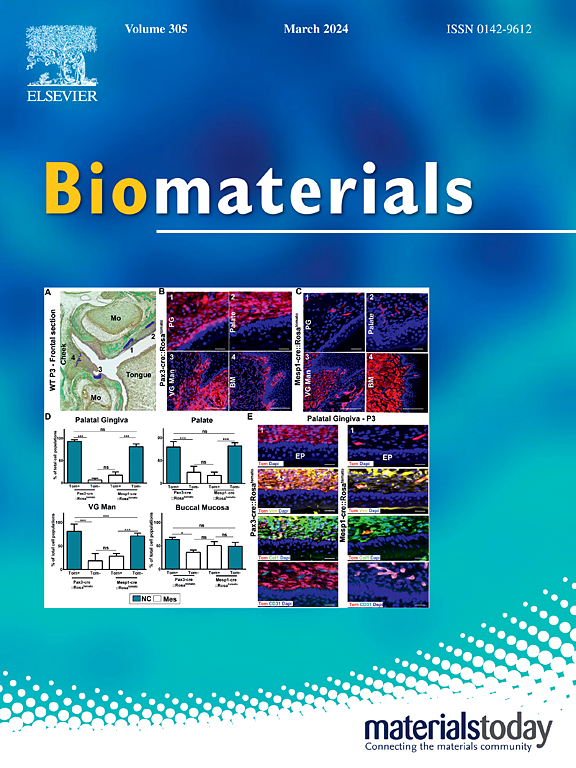A functional cardiac patch with “gas and ion” dual-effect intervention for reconstructing blood microcirculation in myocardial infarction repair
IF 12.8
1区 医学
Q1 ENGINEERING, BIOMEDICAL
引用次数: 0
Abstract
Postinfarction revascularization is critical for repairing the infarcted myocardium and for stopping disease progression. Considering the limitations of surgical intervention, engineered cardiac patches (ECPs) are more effective in establishing rich blood supply networks. For efficacy, ECPs should promote the formation of more mature blood vessels to improve microcirculatory dysfunction and mitigate hypoxia-induced apoptosis. Developing collateral circulation between infarcted myocardium and ECPs for restoring blood perfusion remains a challenge. Here, an ion-conductive composite ECPs (GMA@OSM) with powerful angiogenesis-promoting ability was constructed. Based on dual-effect intervention of oxygen and strontium, the developed ECPs can promote the formation of high-density circulating microvascular network at the infarcted myocardium. In addition, the GMA@OSM possesses effective reactive oxygen species-scavenging capacity and can facilitate electrophysiological repair of myocardium with ionic conductivity. In vitro and in vivo studies indicate that the multifunctional GMA@OSM ECPs form well-developed collateral circulation with infarcted myocardium to protect cardiomyocytes and improve cardiac function. Overall, this study highlights the potential of a multifunctional platform for developing collateral circulation, which can lead to an effective therapeutic strategy for repairing myocardial infarction.

“气离子”双效介入心脏贴片在心肌梗死修复中重建血液微循环的应用
梗死后血运重建对于修复梗死心肌和阻止疾病进展至关重要。考虑到手术干预的局限性,工程心脏贴片(ECPs)在建立丰富的血液供应网络方面更有效。从疗效上看,ECPs应促进更成熟血管的形成,改善微循环功能障碍,减轻缺氧诱导的细胞凋亡。建立梗死心肌和ecp之间的侧支循环以恢复血液灌注仍然是一个挑战。本文构建了一种具有强大促血管生成能力的离子导电复合ECPs (GMA@OSM)。在氧和锶双效干预的基础上,发达的ECPs可促进梗死心肌高密度循环微血管网络的形成。此外,GMA@OSM具有有效的活性氧清除能力,可以通过离子电导率促进心肌的电生理修复。体外和体内研究表明,多功能GMA@OSM ECPs与梗死心肌形成发育良好的侧支循环,保护心肌细胞,改善心功能。总的来说,这项研究强调了开发侧枝循环的多功能平台的潜力,这可能导致修复心肌梗死的有效治疗策略。
本文章由计算机程序翻译,如有差异,请以英文原文为准。
求助全文
约1分钟内获得全文
求助全文
来源期刊

Biomaterials
工程技术-材料科学:生物材料
CiteScore
26.00
自引率
2.90%
发文量
565
审稿时长
46 days
期刊介绍:
Biomaterials is an international journal covering the science and clinical application of biomaterials. A biomaterial is now defined as a substance that has been engineered to take a form which, alone or as part of a complex system, is used to direct, by control of interactions with components of living systems, the course of any therapeutic or diagnostic procedure. It is the aim of the journal to provide a peer-reviewed forum for the publication of original papers and authoritative review and opinion papers dealing with the most important issues facing the use of biomaterials in clinical practice. The scope of the journal covers the wide range of physical, biological and chemical sciences that underpin the design of biomaterials and the clinical disciplines in which they are used. These sciences include polymer synthesis and characterization, drug and gene vector design, the biology of the host response, immunology and toxicology and self assembly at the nanoscale. Clinical applications include the therapies of medical technology and regenerative medicine in all clinical disciplines, and diagnostic systems that reply on innovative contrast and sensing agents. The journal is relevant to areas such as cancer diagnosis and therapy, implantable devices, drug delivery systems, gene vectors, bionanotechnology and tissue engineering.
 求助内容:
求助内容: 应助结果提醒方式:
应助结果提醒方式:


